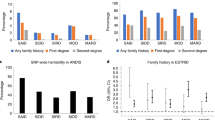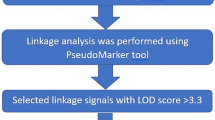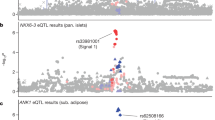Abstract
To confirm and fine map previous reports of association, the Type I Diabetes (T1D) Genetics Consortium (T1DGC) assembled a large collection of DNA samples from affected sib-pair (ASP) families with T1D (5003 affected individuals) and genotyped polymorphic markers. One of these loci, involving the IL2RA gene, had been reported to be due to three independent effects. The T1DGC genotyped 69 single-nucleotide polymorphisms (SNPs) that span ∼88 kb from the 5′ flanking to 3′ flanking region of the IL2RA locus. The most highly associated SNP reported earlier (ss52580101) was not included in the genotyping list; however, a 5-SNP (rs3134883, rs3118470, rs7072793, rs4749955 and rs12251307) haplotype (H5) was identified that strongly tagged its minor allele with r2=0.869 (95% CI, 0.850–0.885). This haplotype was significantly protective (P=3.2 × 10−5) in the T1D ASP families, with an odds ratio virtually identical to that reported for ss52580101. The SNP marking the second independent locus, (rs11594656) showed no association in the T1DGC set and the third (rs2104286) could not be distinguished, by conditional regression, from H5. Instead, the most significant independent effect was detected from the 5′ flanking IL2RA SNP rs4749955, which remained significant after regression for H5. Thus, we confirm independent effects at the IL2RA locus.
This is a preview of subscription content, access via your institution
Access options
Subscribe to this journal
Receive 6 digital issues and online access to articles
$119.00 per year
only $19.83 per issue
Buy this article
- Purchase on Springer Link
- Instant access to full article PDF
Prices may be subject to local taxes which are calculated during checkout

Similar content being viewed by others
References
Lowenthal JW, Zubler RH, Nabholz M, MacDonald HR . Similarities between interleukin-2 receptor number and affinity on activated B and T lymphocytes. Nature 1985; 315: 669–672.
Wang X, Rickert M, Garcia KC . Structure of the quaternary complex of interleukin-2 with its alpha, beta, and gammac receptors. Science 2005; 310: 1159–1163.
Shevach EM . Certified professionals: CD4(+)CD25(+) suppressor T cells. J Exp Med 2001; 193: F41–F46.
Willerford DM, Chen J, Ferry JA, Davidson L, Ma A, Alt FW . Interleukin-2 receptor [alpha] chain regulates the size and content of the peripheral lymphoid compartment. Immunity 1995; 3: 521.
Vella A, Cooper JD, Lowe CE, Walker N, Nutland S, Widmer B et al. Localization of a type 1 diabetes locus in the IL2RA/CD25 region by use of tag single-nucleotide polymorphisms. Am J Hum Genet 2005; 76: 773–779.
Qu H-Q, Montpetit A, Ge B, Hudson TJ, Polychronakos C . Toward further mapping of the association between the IL2RA locus and type 1 diabetes. Diabetes 2007; 56: 1174–1176.
Lowe CE, Cooper JD, Brusko T, Walker NM, Smyth DJ, Bailey R et al. Large-scale genetic fine mapping and genotype-phenotype associations implicate polymorphism in the IL2RA region in type 1 diabetes. Nat Genet 2007; 39: 1074–1082.
Qin ZS, Niu T, Liu JS . Partition-ligation-expectation-maximization algorithm for haplotype inference with single-nucleotide polymorphisms. Am J Hum Genet 2002; 71: 1242–1247.
Stephens M, Donnelly P . A comparison of bayesian methods for haplotype reconstruction from population genotype data. Am J Hum Genet 2003; 73: 1162–1169.
Hakonarson H, Grant SF, Bradfield JP, Marchand L, Kim CE, Glessner JT et al. A genome-wide association study identifies KIAA0350 as a type 1 diabetes gene. Nature 2007; 448: 591–594.
Koeleman BPC, Dudbridge F, Cordell HJ, Todd JA . Adaptation of the extended transmission/disequilibrium test to distinguish disease associations of multiple loci: the Conditional Extended Transmission/Disequilibrium Test. Ann Hum Genet 2000; 64: 207–213.
Maier LM, Lowe CE, Cooper J, Downes K, Anderson DE, Severson C et al. IL2RA genetic heterogeneity in multiple sclerosis and type 1 diabetes susceptibility and soluble interleukin-2 receptor production. PLoS Genet 2009; 5: e1000322.
Brown WM, Pierce JJ, Hilner JE, Perdue LH, Lohman K, Lu L et al. and the Type I Diabetes Genetics Consortium. Overview of the Rapid Response data. Genes Immun 2009; 10 (Suppl 1): S5–S15.
Horvath S, Xu X, Laird NM . The family based association test method: strategies for studying general genotype—phenotype associations. Eur J Hum Genet 2001; 9: 301–306.
Dudbridge F . Pedigree disequilibrium tests for multilocus haplotypes. Genet Epidemiol 2003; 25: 115–121.
Acknowledgements
The Type I Diabetes Genetics Consortium (T1DGC) is funded by the NIH Grant U01-DK62418. This study was additionally funded by the Juvenile Diabetes Research Foundation International, Genome Canada and the Children's Hospital of Philadelphia. We thank all the T1D families for their participation in the study. HQQ is supported by a fellowship from the Canadian Institutes of Health Research. Special thanks for helpful discussion and comments from Joanna Howson. Genotyping was performed at the Broad Institute Center for Genotyping and Analysis is supported by grant U54 RR020278 from the National Center for Research Resources.
Author information
Authors and Affiliations
Consortia
Corresponding author
Rights and permissions
About this article
Cite this article
Qu, HQ., Bradfield, J., Bélisle, A. et al. The type I diabetes association of the IL2RA locus. Genes Immun 10 (Suppl 1), S42–S48 (2009). https://doi.org/10.1038/gene.2009.90
Published:
Issue Date:
DOI: https://doi.org/10.1038/gene.2009.90
Keywords
This article is cited by
-
PTPN22 gene and IL2RA rs11594656, rs2104286 gene variants: additional insights of polygenic single-nucleotide polymorphisms’ pattern among Egyptian children with type 1 diabetes
Egyptian Pediatric Association Gazette (2021)
-
Pre-diagnostic genotyping identifies T1D subjects with impaired Treg IL-2 signaling and an elevated proportion of FOXP3+IL-17+ cells
Genes & Immunity (2017)
-
Tracing environmental markers of autoimmunity: introducing the infectome
Immunologic Research (2013)
-
Proceedings of the Tenth Annual UT-ORNL-KBRIN Bioinformatics Summit 2011
BMC Bioinformatics (2011)
-
An autoimmune-associated variant in PTPN2 reveals an impairment of IL-2R signaling in CD4+ T cells
Genes & Immunity (2011)



